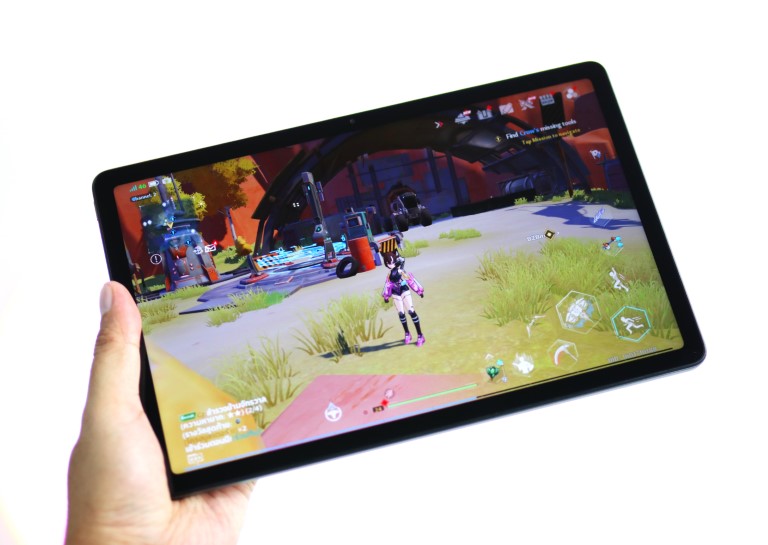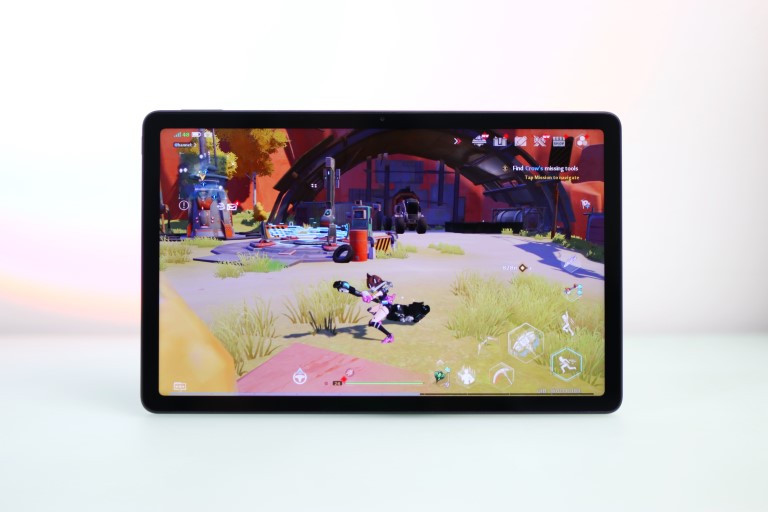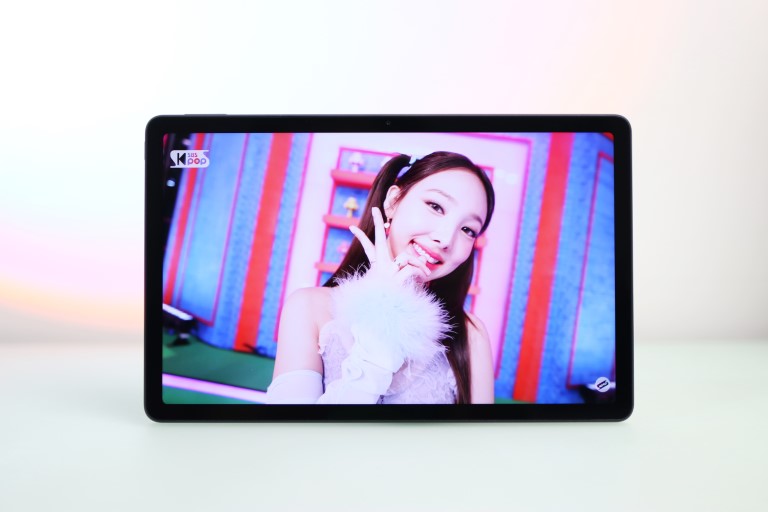Xiaomi has recently made available its latest tablet in the Philippines, the Redmi Pad. This is actually the first tablet under the Redmi line, sporting a 10.61-inch display and powered by a Helio G99 chipset for under PHP 15K. Is this an excellent choice, or are you better off with other tablets? Find out in our review.
Table of Contents

The Xiaomi Redmi Pad shares a similar look with other mid-range tablets like the realme Pad and the OPPO Pad Air. It has relatively thin bezels with just enough thickness so you can comfortably rest your thumbs on it without the touch screen. It’s designed to be used in landscape, and from this orientation, you can find the 8MP front camera above the screen.

On the left, we have the power/lock button and the two loudspeakers.

On the right, we have the USB-C port and two more loudspeakers.

Above the tablet are the volume buttons, microphones, and a microSD card slot.

Flip it on its back and you will see 8MP main camera. The camera module is too large for a single shooter but it’s obvious that it’s just for aesthetic purposes.

The Redmi Pad uses a metal body with a minimalist design. It has a matte finish, which feels cold on the hands and repels fingerprints well. The sides are flat and have rounded corners. At 7.1mm, it’s slim and easy to hold. The edges feel sharp, though, and a bit hefty at 465 g. Although it looks and feels sturdy, it would have been nicer, though, if Xiaomi included a protective case in the package.
The Redmi Pad has a 10.61-inch display with a 2000 x 1200 resolution or equal to 220ppi. It’s a decent resolution and you won’t immediately notice the pixels when viewed at a normal distance. It uses IPS so it has natural colors. Viewing angles are ok but we notice that it is dimmer when you shift the angle a bit.


It has a maximum brightness of 400 nits and a maximum refresh rate of 90Hz. You can choose the default option if you want the system to automatically adjust the refresh rate between 60Hz and 90Hz depending on your activity.

When it comes to audio, the Redmi Pad has four speakers with support for Dolby Atmos. However, the quality is a bit underwhelming as it sounded like they’re equipped with generic speakers. The mids are weak and the highs are tinny, but since there are four of them, it sounded immersive. There’s a subtle hint of bass, though, so we’ll give it that. It’s good enough for casual viewing and gaming.

The Redmi Pad is equipped with a single 8MP main rear camera and an 8MP ultra-wide front camera. The cameras are not its strongest features and there’s not much to expect from 8MP shooters. Autofocus is a bit slow and shots would sometimes come out of focus. There are not a lot of details in the images but the colors are accurate.
We could say that the cameras are here for video calls or meetings. It would still be good for social media uploads but the lighting conditions must be ideal before you can really take quality images. When it comes to shooting videos, it can record at a maximum of 1080p at 30fps.

The Xiaomi Redmi Pad runs on MIUI 13.1.4 based on Android 12. The UI is easy to navigate and uses multiple home screens to house the apps. It’s like MIUI for smartphones but optimized for landscape use. There’s Dark Mode, Split Screen, Floating Windows, Game Turbo, as well as security and privacy features in the Security app.

There are not a lot of bloat apps and only includes Xiaomi’s built-in apps, Google apps, and WPS Office, which is good considering there’s a 64GB model available.
Powering the Redmi Pad is a MediaTek Helio G99 6nm chipset with an octa-core CPU, Mali-G57 MC2 GPU, 4GB or 6GB RAM, and 64GB or 128GB UFS 2.2 storage. There’s a RAM extension feature that adds a virtual 2GB when the system needs it.

Performance is good when it comes to menial tasks and handling basic apps. There are no issues when using social media and streaming apps. Light gaming shouldn’t be an issue but you’ll need to adjust if you’re going to run more demanding games like Tower of Fantasy. In our case, we have to lower the resolution to Balanced, HD resolution and 30 fps for a smoother experience. Check out the benchmarks below:
• AnTuTu v9 – 260,655
• AnTuTu v9 Storage Test – 43,172, 994.5 MB/s (Seq. Read), 896.5 MB/s (Seq. Write)
• PC Mark – 9,555 (Work 3.0)
• 3D Mark – 1,244 (Wild Life), 342 (Wild Life Extreme)
• Geekbench 5 – 546 (Single-Core), 1,808 (Multi-Core), 1,418 (OpenCL)
The Redmi Pad only has WiFi 5, Bluetooth 5.3, and USB-C, which is pretty basic for a WiFi-only tablet. The battery is huge, though, at 8,000mAh with 18W fast charging. PC Mark rated the battery at 21 hours and 32 minutes while our video playback test got us more than 24 hours which is good.
The Redmi Pad has the makings of a decent tablet for entertainment. It has a premium design, a nice screen, immersive speakers, and a big battery. It is competitively priced too at PHP 13,999 for the 4GB + 128GB, and PHP 14,999 for the 6GB + 128GB. It’s positioned better compared to its competitors from other brands.

However, it’s priced too close to its cousin the Xiaomi Pad 5 110. The 6GB + 128GB is now priced at PHP 15,999 and has a better display with a higher refresh rate, a more powerful Snapdragon 860 chipset, faster UFS 3.1 storage, a better camera, and an even bigger battery with faster charging. In this case, I’d recommend just bumping the budget a bit for this one so you can get more hardware for the price.
Xiaomi Redmi Pad specs:
10.61-inch (2000 x 1200) IPS display, 220ppi
90Hz refresh rate
MediaTek Helio G99 SoC
Mali-G57 MC2 GPU
3GB, 4GB, 6GB RAM
64GB, 128GB UFS 2.2
microSD card slot
8MP rear camera
8MP ultra-wide front camera
WiFi 5
Bluetooth 5.3
USB-C
Quad-speakers
MIUI 13 (Android 12)
8,000mAh battery w/ 18W fast charging
250.5 x 158.1 x 7.1 cm
465 g
Mint Green, Moonlight Silver, Graphite Grey

YugaTech.com is the largest and longest-running technology site in the Philippines. Originally established in October 2002, the site was transformed into a full-fledged technology platform in 2005.
How to transfer, withdraw money from PayPal to GCash
Prices of Starlink satellite in the Philippines
Install Google GBox to Huawei smartphones
Pag-IBIG MP2 online application
How to check PhilHealth contributions online
How to find your SIM card serial number
Globe, PLDT, Converge, Sky: Unli fiber internet plans compared
10 biggest games in the Google Play Store
LTO periodic medical exam for 10-year licenses
Netflix codes to unlock hidden TV shows, movies
Apple, Asus, Cherry Mobile, Huawei, LG, Nokia, Oppo, Samsung, Sony, Vivo, Xiaomi, Lenovo, Infinix Mobile, Pocophone, Honor, iPhone, OnePlus, Tecno, Realme, HTC, Gionee, Kata, IQ00, Redmi, Razer, CloudFone, Motorola, Panasonic, TCL, Wiko
Best Android smartphones between PHP 20,000 - 25,000
Smartphones under PHP 10,000 in the Philippines
Smartphones under PHP 12K Philippines
Best smartphones for kids under PHP 7,000
Smartphones under PHP 15,000 in the Philippines
Best Android smartphones between PHP 15,000 - 20,000
Smartphones under PHP 20,000 in the Philippines
Most affordable 5G phones in the Philippines under PHP 20K
5G smartphones in the Philippines under PHP 16K
Smartphone pricelist Philippines 2024
Smartphone pricelist Philippines 2023
Smartphone pricelist Philippines 2022
Smartphone pricelist Philippines 2021
Smartphone pricelist Philippines 2020
geometry dash says:
It can connect wireless keyboard or not?
Abe Olandres says:
You can.
Mar says:
Nerdlix compatible?
melsong says:
does it have screen protection?